We have much more to do and your continued support is needed now more than ever.
Road to the Final Fur: Round Two
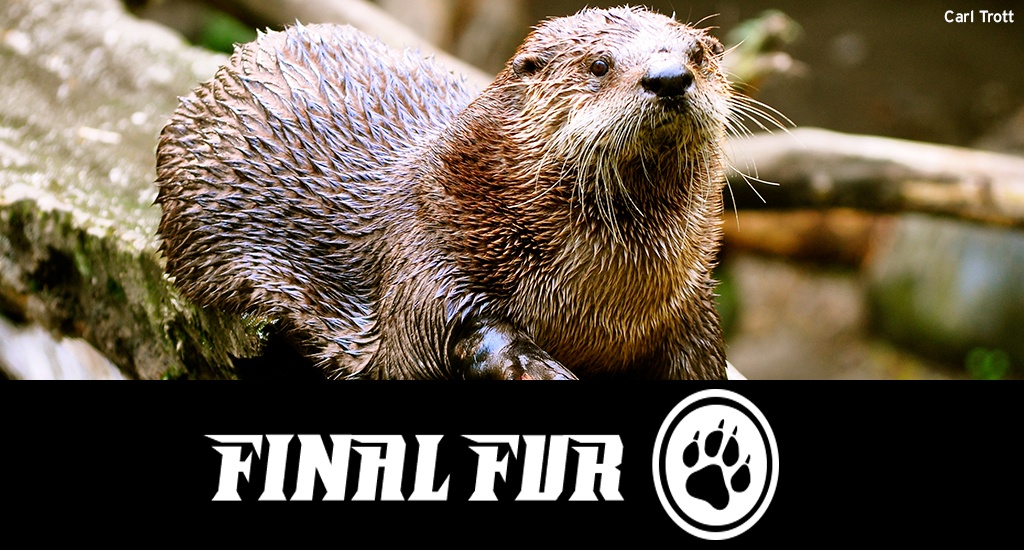
The Road to the Final Fur kicked off in a furrenzy of competition! But only sixteen fierce species were able to advance to Round 2. Hailing from habitats that run the gamut from extreme cold to desert heat, these species are born to weather even the toughest conditions. Luckily, they have the backing of our regional centers and affiliate partners, whose on-the-ground work directly impacts the habitat of each and every one of them. Learn more about the homes of the remaining sixteen and get connected to the regional center in your area.
Vote Now
Beasts of the Northeast
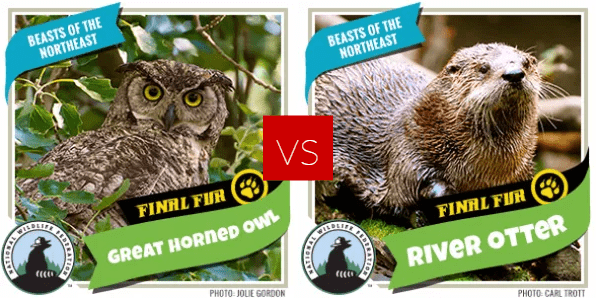
GREAT HORNED OWL
A solitary bird that lives in forests, canyons, and clearings, the great horned owl is found throughout the continental US and up into Alaska. Their geographic range extends southward into Mexico and Central and South America.
Learn more about the work our Mid-Atlantic Regional Center does to support wildlife >>
RIVER OTTER
River otters can thrive in any fresh water habitat, from ponds and marshes to lakes and rivers, as long as the habitat provides adequate food. Their dens are abandoned burrows or empty hollows and have entrances underwater.
Learn more about the work our Great Lakes Regional Center does to support wetlands >>
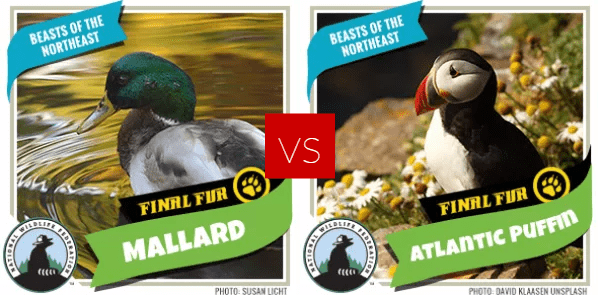
MALLARD
Mallards are among the most recognizable birds in the world. They can be found throughout the world, including all of the continental United States and Hawaii. Look for them near ponds and freshwater wetlands.
Learn more about the work our Great Lakes Regional Center does to support wildlife >>
ATLANTIC PUFFIN
The Atlantic puffin is a sea bird through and through. Though they nest on the same on rocky sea cliffs each year to breed, puffins spend the rest of their time on the open ocean, far from land.
Learn more about the work our Northeast Regional Center does to support coastal habitat >>
It’s a Southern Thing
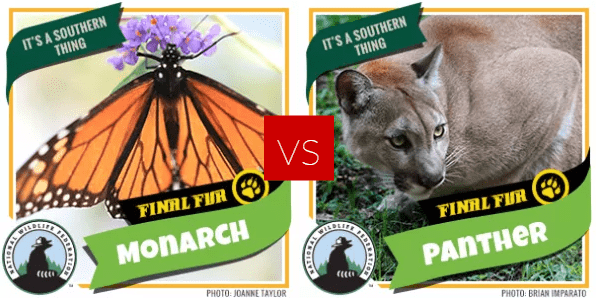
MONARCH
Monarch butterflies are migratory animals. In the spring, summer, and early fall they can be found wherever there are milkweeds for them to lay their eggs. Monarchs cannot survive freezing temperatures, so they winter in the cool, high mountains of central Mexico and woodlands in central and southern California.
Learn more about the work our South Central Regional Center does to support wildlife >>
FLORIDA PANTHER
Florida panthers live in wetlands, swamps, upland forests, and stands of saw palmetto. The historic range of the Florida panther extended throughout the Gulf Coast states, from Florida to Louisiana and up to Arkansas. Today, there are less than 100 Florida panthers left in the wild. They are found in southern Florida swamplands, like the Everglades National Park and Big Cypress National Preserve. The species is so critically endangered that it is vulnerable to just about every major threat – from habitat loss to cars and feline diseases.
Learn more about the work our South Central Regional Center does to support habitat >>
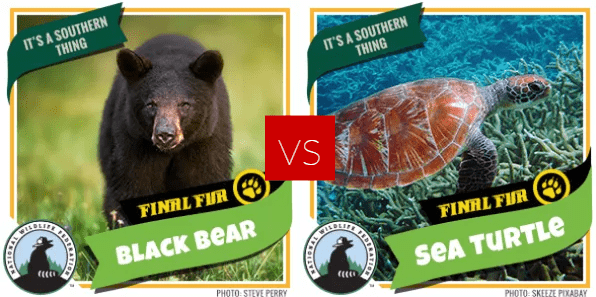
BLACK BEAR
The American black bear’s range covers most of the North American continent. They are found in Alaska, much of Canada and the United States, and extend as far south as northern Mexico. They inhabit both coniferous and deciduous forests, as well as open alpine habitats. They can live just about anywhere they can find food, but most frequently where there are trees.
Learn more about the work our Mid-Atlantic Regional Center does to support wildlife >>
GREEN SEA TURTLE
Green sea turtles have ocean water habitats and separate nesting habitats. Once a green sea turtle hatches and heads into ocean waters they rarely return to land. Instead, they feed on off-shore plant blooms around islands and beaches in warm tropical and subtropical ocean waters.
Green sea turtles will travel long distances, even across oceans, to return to their preferred breeding site. In the nesting season, females emerge onto the warm beaches to lay their eggs before returning to the sea until the next breeding season.
Learn more about the ways our South Central Regional Center supports habitat restoration >>
Home on the Range

MOUNTAIN LION
Mountain lions inhabit a wide range of ecosystems, making their home anywhere there is shelter and prey, including mountains, forests, deserts, and wetlands. They are territorial and have naturally low population densities, which means the species requires large swaths of wilderness habitat to thrive. The mountain lion’s range spreads all across the Americas, from the Canadian Yukon to The Strait of Magellan, the greatest of range any extant mammal in the Americas.
Learn more about the work our California Regional Center does to support wildlife >>
BALD EAGLE
Bald eagles really like lakes. During the summer, they can be seen soaring above lakes and in the nearby trees. They prefer bodies of water with lots of fish and surrounding forests. In the winter, bald eagles can be found near hunting along coastlines, reservoirs, and rivers. Most Americans will only see bald eagle during their winter migration, when they can be found near a variety of water habitats.
Learn more about the work that our Northern Rockies, Prairies and Pacific Regional Center does to support this ecosystem >>

PRAIRIE DOG
Black-tailed prairie dogs are highly social animals native to the Great Plains. These small rodents live in massive underground colonies called towns. Though they were once extremely populous, their numbers have decreased significantly because of habitat destruction and human intervention.
Learn more about the work our regional office does to support wildlife in the prairies >>
BIGHORN SHEEP
Bighorn sheep live in the western mountainous regions of North America, ranging all the way from southern Canada to Mexico. Their steep mountainous habitat, with ledges sometimes only 2” wide, provide cover from predators such as bears, golden eagles, mountain lions, and Canada lynx. Most populations move seasonally – they prefer larger upland areas in the summer and concentrate in sheltered valleys during the winter.
Learn more about the work our Rocky Mountains Regional Center does to preserve habitat >>
You CAN Handle the Chill
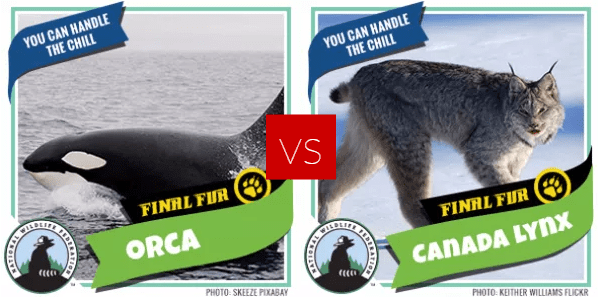
ORCA
Found in every ocean on the planet, orcas are likely the most widely distributed mammal in the world, after humans. There are three distinct types of orca: transient, resident, and offshore. Though they are not officially considered different subspecies, all three types of orca are genetically distinct and do not interbreed or mingle. Residents live close to shore in large pods of about 10-20 and feed primarily on fish. Offshore orcas are similar to residents, but are distinguished by their smaller overall size and rounded, nicked fins. Transient orcas live in smaller groups of about 3-7 and spend their lives out at sea where they prey on seals, sea lions and other dolphins (which, strangely, are the same animals that resident orcas like to swim and play with).
Learn more about the work our regional center does in the Pacific Northwest >>
CANADA LYNX
The great grey ghost of the north, these elusive cats used to be (slightly) more common in the United States than they are today. Although they were never abundant, their historical range did include most northern states from the Rockies to New England. Today, while tens of thousands of lynx remain in Canada and Alaska, loss of habitat and human activity limit their presence in the continental US. However, in the past few years there have been some signs of population recovery in northeastern states.
Learn more about how our Northeast Regional Center protects vulnerable wildlife >>

POLAR BEAR
Though they will spend time on land, polar bears depend on sea ice, where they can hunt for their food. Polar bears are excellent swimmers and they will travel long distances between shore and the sea ice, if necessary. However, these long swims can be perilous for both cubs and adult bears. The permanent, multi-year ice that doesn’t melt seasonally is critically important to their survival, though it is increasingly rare because of climate change.
Learn more about how our Northern Rockies, Prairies and Pacific Regional Center protects wildlife >>
ARCTIC FOX
These small omnivores have quite a large range. They call the entire arctic tundra home, which means the arctic fox is quite literally sitting on top of the world. Their small, compact bodies are uniquely adapted to live in a frigid climate. They can even use their large tails as cover to keep them warm when things get especially chilly.
Learn more about how our Northeast Regional Center helps preserve habitat >>
Now that you’ve got your sea legs, vote each day for your favorites! Round 3 opens on Saturday, March 11th.
Vote Now





















